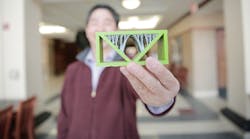One of the stumbling blocks with additive manufacturing is the support structures required to keep the object being 3D-printed stable during the creation process. Building and removing these “sacrificial structures” without damaging the completed product can be time-consuming and costly.
Xiaoping Qian, a mechanical engineering professor at the University of Wisconsin-Madison, recently came up with a method that reduces the need for those supportive materials and may eliminate them entirely in time. Previously, Qian made additive-manufactured parts designed to dissipate heat. The next improvement was to go beyond optimizing the final part and do the same with the support structures.
Making Enhancements with Computer Models
The typical method of making support materials is to analyze the geometrical dimensions of the overall item made through additive manufacturing, then build columns to promote stability. But that method requires makers to know a part’s geometry ahead of time, which can slow down the prototyping process. Qian’s approach depends on computer-assisted design models that assess the amount of sacrificial material required, and does not require exact measurements in advance.
Typically, manufacturers use a technique called "topography optimization" to determine the amount and distribution of material based on the piece's final dimensions and load-bearing requirements. Engineers begin by inputting details about a component's geometry into a computer system. Then, the computer gives feedback to suggest topography optimization strategies.
It’s most common, of course, for parts to need support structures for pieces featuring downward-sloping surfaces. Qian’s method defines a new measurement called the "projected undercut perimeter." He confirmed that it essentially matches the area of the additive-manufactured part. Then, it's possible to control for the amount and angle of the overhang in a given layer.
Thanks to that new information, Qian's method substantially reduces the need for support structure material. One of Qian's projects needed 43 percent less support material than projects made with conventional methods. Even better, he accomplished that using readily available software for commercial design purposes.
A lessened need for sacrificial structures means manufacturers could save money on those materials, plus streamline the build time for additive-manufactured pieces.
There are also efforts to make 3D-printed pieces with shapes that don't need support structures. Boeing, for instance, made the first-ever 3D-printed metal satellite antenna that did not require supports.
Qian, who is patenting his technology through the Wisconsin Alumni Research Foundation, is hoping this research will lead to a much larger initiative devoted to innovative ways of designing self-supporting parts for additive manufacturing. His most recent findings give a glimpse of what's possible.
Kayla Matthews writes the blog Productivity Bytes and covers manufacturing technologies for publications such as Industrial Machinery Digest, American Machinist, Machine Design and Thomas Insights.




